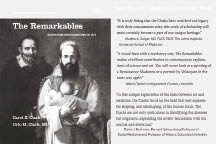Carol Zeller Clark thought that a 17th-century painting of the Biblical character Judith, who decapitated the Assyrian general, Holofernes, would be an ideal cover for The Remarkables: Endocrine Abnormalities in Art (University of California Press, 2011) a graphic but scholarly work. Her daughters insisted on something more provocative: a jaw-dropping image of what appears to be a solemn bearded man—with a voluptuous exposed breast—nursing an infant graces the cover.
The 1631 painting, by Jusepe de Ribera, perfectly illustrates the subject that Clark and her husband, Orlo Clark, tackled with enthusiasm and meticulous detail: how artists have portrayed people afflicted with endocrine disorders that cause goiters, sexual ambiguity, and dwarfism. Their book melds the couple’s passion for art with Orlo Clark’s expertise as a surgeon and endocrine specialist.
The San Francisco couple spent seven years researching and writing the work, making annual trips to Italy and Europe to study paintings and to probe the attitudes of artists and their contemporaries toward their subjects. The University of California Medical Humanities Consortium, which has produced other volumes exploring comedy and medicine, as well as biomedical politics, published the book in 2011. The first printing has nearly sold out, prompting an additional print run.
The curious cover art depicts a 17th-century Italian woman, Magdalena Ventura, who was considered a freak due to her masculine appearance, facial hair, and receding hairline. Supposedly 53 when she gave birth, she likely suffered from an ovarian tumor, says Clark.
The painting of Judith, Clark’s original cover choice, appears in the book because artist Artemesia Gentileschi depicted her with a prominent goiter. Her swollen neck indicated a distended thyroid gland, the result of an iodine deficiency. Signaling sensuality and even erotic beauty, goiters appear in works by Caravaggio, Jan Steen, and Rubens, all of whom likely faithfully reproduced their models’ distended necks.
Though Clark majored in English at Barnard—and had a long career as a high school English teacher—she nurtured her passion for art with courses and reading. She became passionate about travel and art after living in London between her sophomore and junior years at Barnard. “From that point on, I vowed I would learn as much as I could about art.”
Orlo Clark often included slides of famous artworks in his lectures on endocrine disorders, and eventually the couple realized they had the makings of a book. Clark says she enjoyed working with her husband of 49 years, though finding a consistent writing voice proved a challenge. “His focus was scientific and structural, with not a lot of analysis beyond the scientific,” she says. “There were some issues with organizing. The old English teacher in me can’t shut up.”
A native of Nutley, N.J., Clark first attended Wells College in upstate New York, but realized a rural campus didn’t suit her cosmopolitan tastes. Barnard proved a better fit for a young woman who craved art galleries and off-Broadway theater. She credits Barnard with giving her the tools and self-assurance she needed to research and write an academic work. “Barnard showed me how to be an independent scholar,” says Clark, “and it gave me the confidence to do this project without a university. I had very few qualms… I felt confident I was doing the kind of research my Barnard professors would have been proud of.”
 Long after graduation, she remained in touch with her advisor, Lucyle Hook, and her Romantic literature professor, Alan C. Purves, who taught her honors thesis class. (“We were all a little in love with him,” she says.) Purves, who later joined the Educational Testing Service, sent Clark freelance test-writing work in San Francisco when the newlyweds were struggling to make ends meet on her husband’s $300 monthly residency stipend.
Long after graduation, she remained in touch with her advisor, Lucyle Hook, and her Romantic literature professor, Alan C. Purves, who taught her honors thesis class. (“We were all a little in love with him,” she says.) Purves, who later joined the Educational Testing Service, sent Clark freelance test-writing work in San Francisco when the newlyweds were struggling to make ends meet on her husband’s $300 monthly residency stipend.
Clark earned a master’s degree in English from San Francisco State University and spent 22 years at a private school in the San Francisco area, where she became chair of the English department. The couple has three children, all involved in art, academics, or both.
She retired in 2004 and her husband retired this year. They’re always planning their next travel adventure, and they expect to collaborate on articles for medical-history journals about some of the artworks featured in The Remarkables.
